Published on 31.12.2023
Kärt Ojavee is an artist and designer who combines new technologies with traditional craft. She is interested in the transformation of materials over time, and the ways in which materials are in symbiosis with their environment. Ojavee creates experimental materials and has recently been working with various surplus materials and seaweed biomass, focusing on the value of matter. She is a visiting professor at the Estonian Academy of Arts’ textile department and head of the Craft Studies MA programme together with Juss Heinsalu. Together with Reet Aus, she founded DiMa lab that focuses on sustainable design and materials development. k-o-i.ee
Annika Kaldoja is a designer, interior architect, and lecturer who practises in both product design and interior architecture disciplines. Her design philosophy centres on sustainable values, prioritising functionality, quality, and aesthetics. She aims to create enduring and meaningful designs that gracefully age over time. Kaldoja works from her own established studio and is one of the founders of Studio Aine, a design collective with a focus on material research.
“Its weight, a paradox, for it’s weightless in essence,
challenges our perceptions and defies all precedence.”
03.11.23
The space is ready and exhibits are in their places, the central glowing display case showing processes has finally been fixed and the first weightless material has been placed into the vitrine.
The gallery of the Estonian Academy of Arts is a rectangular space with a high ceiling where the curved external wall of the stairway of the former stocking factory intersects one of the corners. Above the baffles hanging from the ceiling are windows darkened with vinyl and directly opposite the wall of the former factory is an entrance to the main foyer with an internal window above showing a view of the stairway of the new addition to the building. There are two entrances to the gallery from opposite sides of the space: one beside the ground floor foyer of the Academy of Arts, and the other opens onto Kotzebue street.
Everything seems to be working and it was time for the last break. After returning in an hour, the space has changed, something is missing, the vitrine is empty, the material in it has disappeared. As a fragile bio-material it had simply melted away during its floating. Limestone radiates humidity which activates the quick dehydration of the protagonist of the exhibition (299).
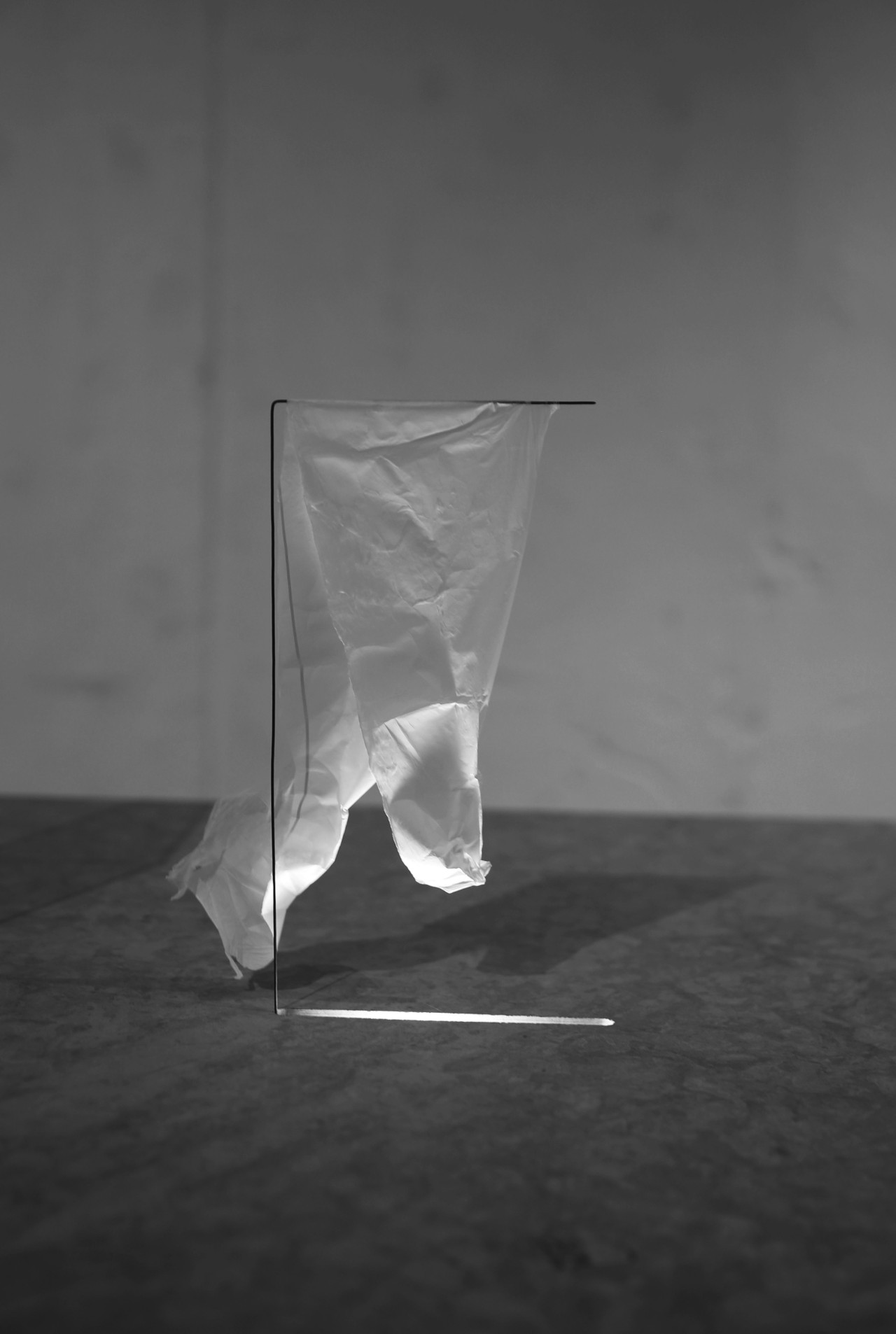
Limestone – at the same time massive and fragile – has arrived in the gallery space only a couple of hours ago: heavy and damp, containing primaeval environments, which have been deposited in dense layers, forming unique patterns. Half of the mass of these primal seas is a sedimentary green algae (mainly Palaeoporella, Vermiporella and Dasycladaceae) deposited more than 400 million years ago.1 Small segmented circular coils, ethereal skeletons, inexplicable forms – an uncountable number of these ancient bright organisms have been preserved as grey fossils. In addition, nanomaterials contain an uncountable number of fibres. Limestone and nanomaterial are both brimming with data: one settled over millions of years, the other recently created using high-tech machinery. The base material is the same: algae and skeletons.
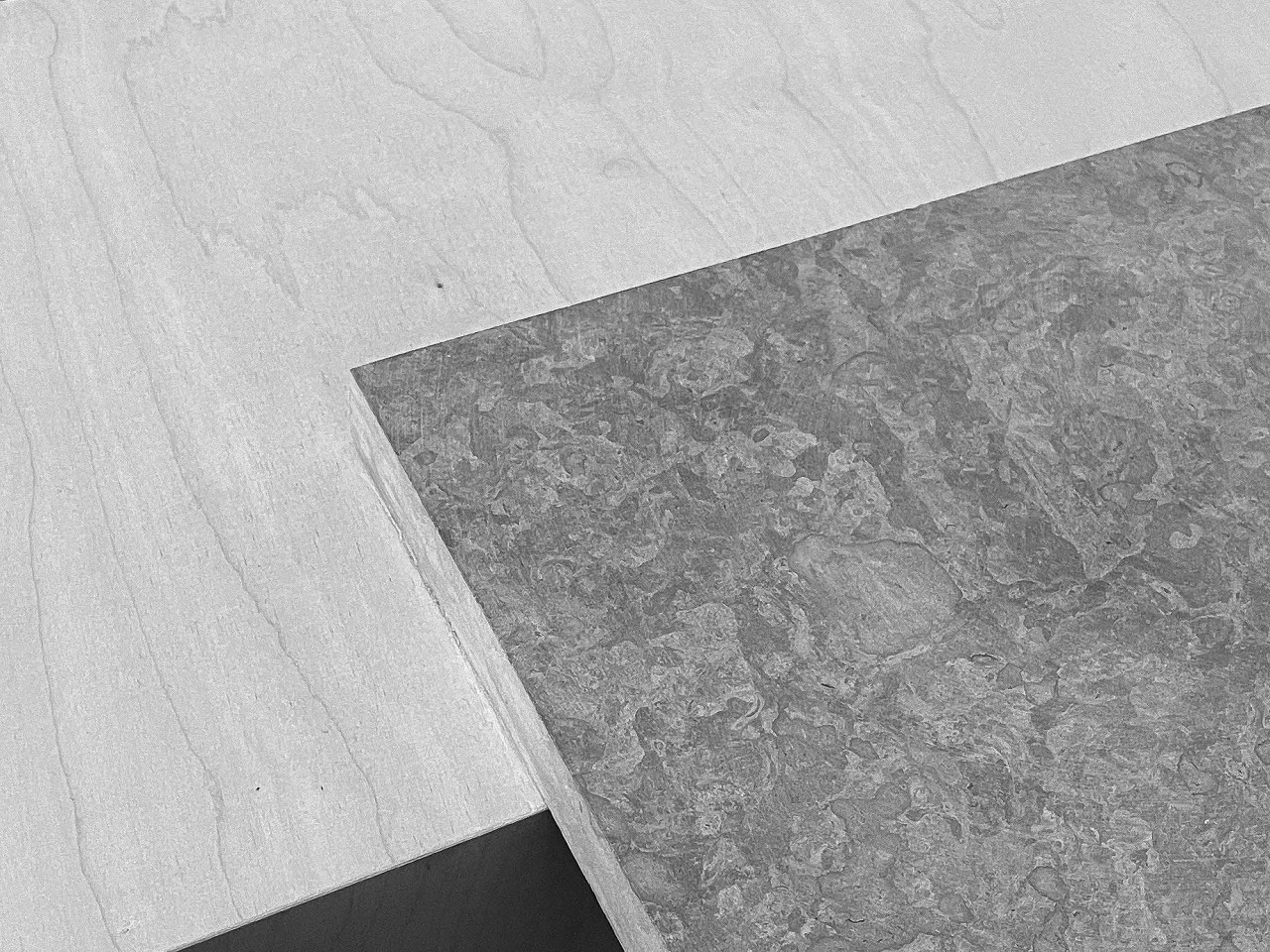
Furcellaran, which has been extracted from algae, is used in the composition of the nanomaterial and can be seen as part of the exhibition on the table showing the process. The use of limestone also introduces the narrative of the sea into the design of the exhibition furniture. Limestone and local red algae bring together the Baltic Sea and the formation of the Estonian coastline. Besides the limestone from the Middle Ordovician epoch, floating weightless nanomaterials were grounded by bulky polygons of birch plywood. These two and glass were the only materials used for the exhibition furniture. This also meant that they were the only materials that the visitor could have a tactile experience of. In the same way as the pattern of the grain of a tree and the structure of limestone are unique, every material which has been spun of fibres in nanoscale looks different under the microscope. Unique patterns, but still sharing a similar tenderness.
“They’re shaped patiently, again and again, through endless tests and tries, much like a story told over and over until it’s just right.”
04.11.23
We dry the lump of rock in the gallery for three more days and try to place the exhibits in the display cases. A familiar rhythm keeps repeating: testing, every day testing again. Does the material disappear or remain? Such rhythmic patterns have accompanied the whole process of refinement and improving the material over a year. Continuous repetition is a characteristic element of material development. How could the same rhythm be conveyed to the viewer in the gallery so that the repetitions would keep repeating and would seem annoying and intriguing at the same time, just as our four-member development team has experienced them?
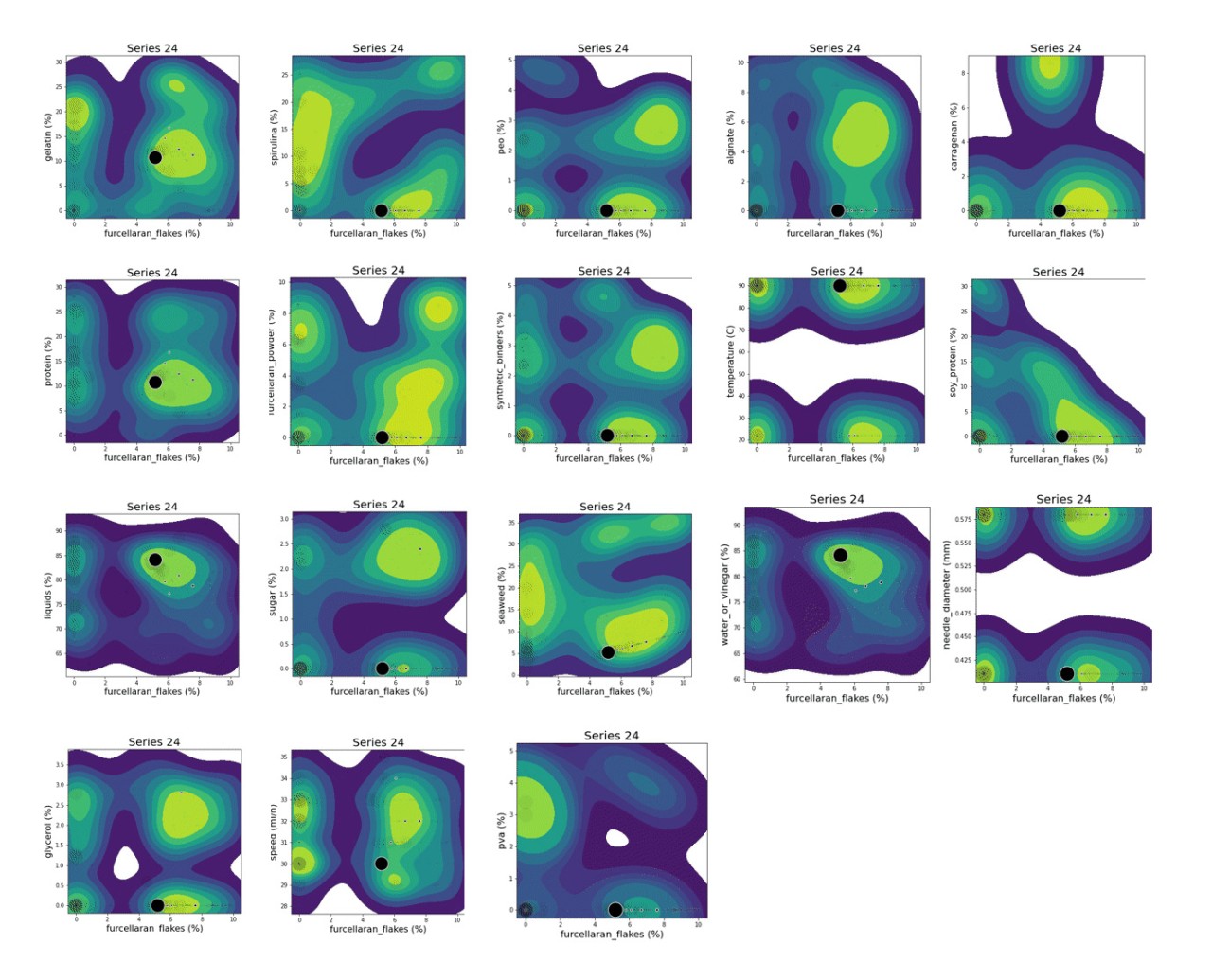
According to the preliminary idea, the exhibition was supposed to consist of two parts where nanomaterial would have held the central role and everything else would act as an accompaniment. This was the foundation of the first designs, which were based on formal repetition, showing the process and the result on a single axis. The final result, where the part explaining the process was at the centre of the space and everything else was arranged around it, evolved during the activities that followed. Such placement worked both semantically – the development of materials is a constant rotation between thinking, producing, analysing and planning – and spatially, because the content of the exhibition and how it would be revealed to the visitor remained the same no matter from which side the gallery was entered. In hindsight, it can be said that the latter also changed the idea of the exhibition: the result and the process felt inseparable and equal. In parallel with designing the furniture details and placing the final objects, the geometry of the furniture and their material was agreed upon and the initial lighting concept was developed.
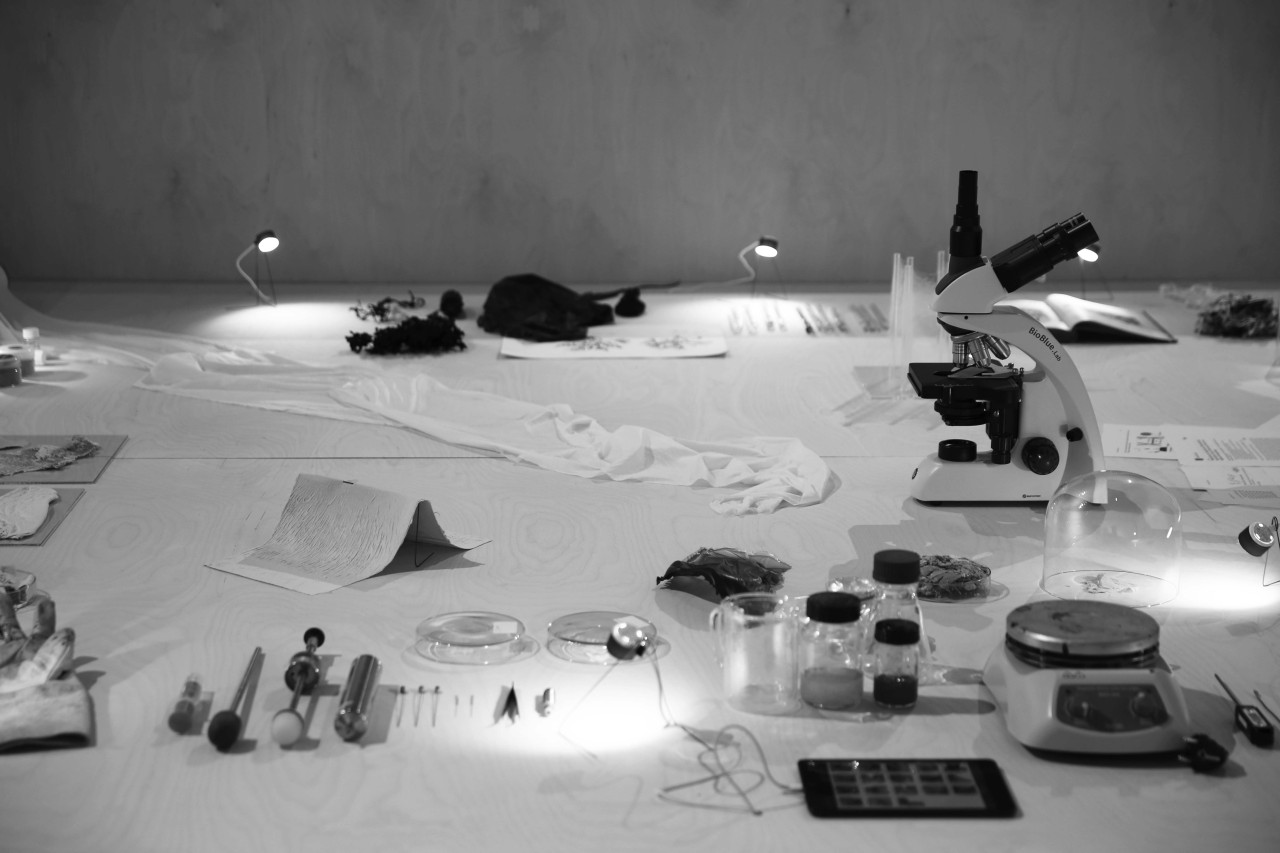
“The tiny things are hidden under veils of everyday sight.”
03.08.23
We try to recreate the repeating rhythms of the process for the 3D animation together with Joosep Volk for the exhibition. The flickering deposition of layers of fibres on the screen and the sounds made by Artjom Astrov which accompany them feel somewhat irritating. Artjom has recorded the sounds from a tape, capturing the microscopic scratches and dust. When the 3D simulation of the material is being prepared, it becomes clear that the virtual fabric requires the construction of a whole matrix, a network, a universe consisting of tiny dots. This process is similar to working with the real material: the base ingredients, the formula and an incalculable number of attempts. At one point, the material starts taking shape inside the matrix. It can be approached from an aerial view and then reframed as the surface of the fabric. In between, the camera keeps wandering in various layers, moving on to the microscopic level. The close-ups in the final animation are so similar to nanomaterial 399 that scientist X, who visited the exhibition, thought for a moment that it must be a documentary video.
Digital technology is often used to visualise an imaginary world and to speculate about the non-existent. Here, however, the logic is the other way round: first, the material is made, and only then the view into it is created, using digital solutions as aids. A world will be revealed which we cannot sense or perceive otherwise.
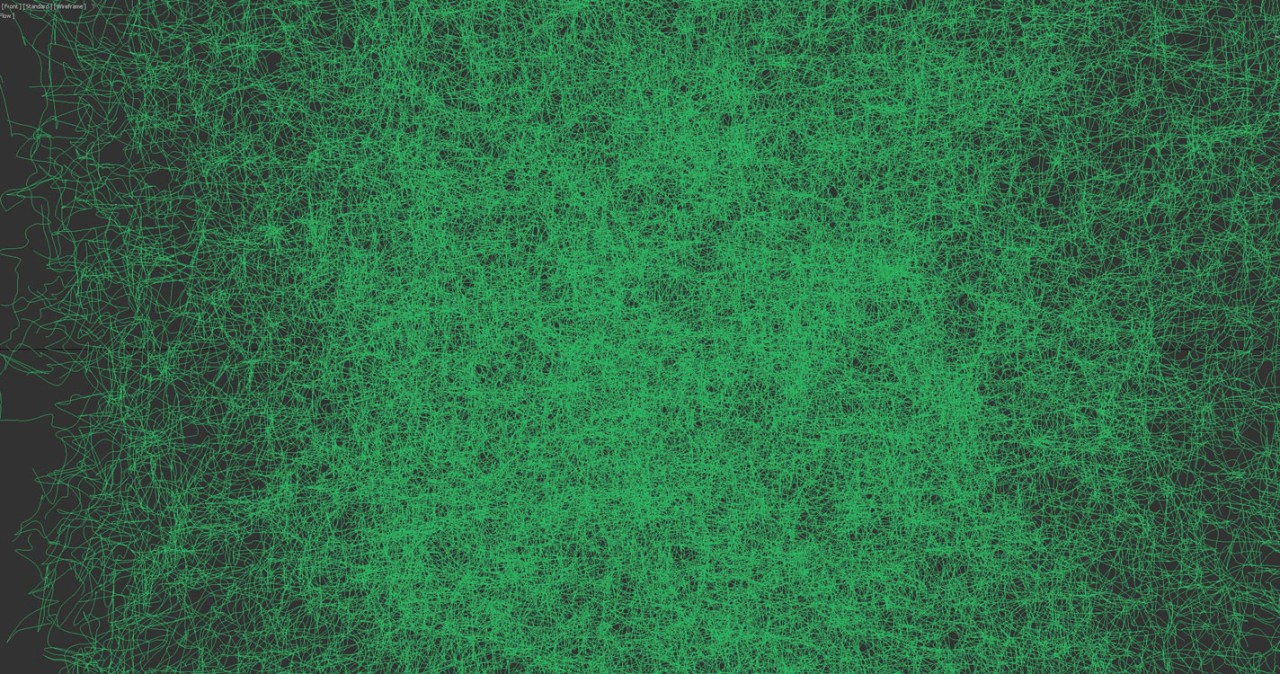
“These tiny bits are so light and so small, almost like they aren’t there at all.”
10.06.22
If a nanometre (nm) is one billionth of a metre (m), then how is it at all possible to analyse and understand what the structure and composition of this material is like. If the base substances have been mixed together and how. We are designing a system that is invisible. There are scientists who claim that everything is a nanomaterial. Everything can be observed on the nanoscale. At the same time, we still need to distinguish materials which have been made on the nanoscale. For example, the following definition has been proposed: nanomaterial is an entity (an independent part of the system) which is measured in nanometres in at least one of its dimensions, or an entity which contains such entities.2
It is known that the materials at the exhibition consist of polysaccharides extracted from local red algae (Furcellaria lumbricalis) and contain additional binding proteins. To reach the final result, 399 experiments were carried out in the lab. Not that many iterations. Over half of the experiments failed because the desired fibre (entity) did not emerge at all or the resulting fibres were not strong enough and thus the material was not stable. There have been many factors involved, beginning with the fact that the base material is mixed together in a liquid state and then preserved at a temperature range of 70–80°C, and concluding with the tension which is used during the spinning because this is the moment when the liquid base material transforms into fibre. The previous description is simplified and dozens of important nuances are left out which can lead to a successful or a failed result. If the material is ready, it (and the entities it contains) can be observed and measured using a scanning electron microscope (SEM). A scene from a wild jungle appears where the viscous base materials twist around each other, clinging to one another, joining together and branching out. Different spaces are left between the joined fibres: potential dwellings for cells, micro organisms, bacteria and the living fibres which, in turn, live on them.
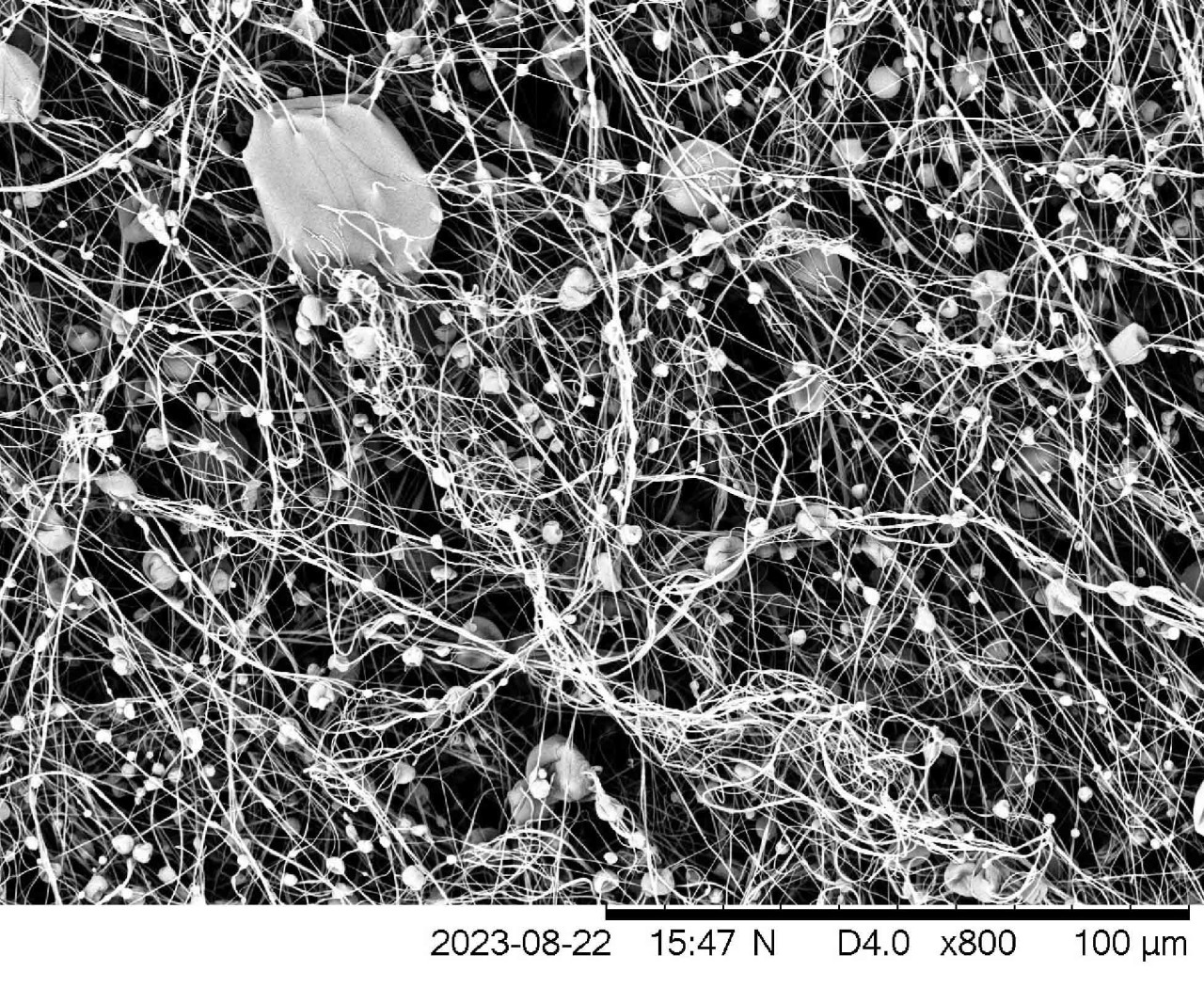
When the visitors entered the gallery, they first experienced the material: floating in the glass displays and on limestone beams, projected as a video onto the gallery wall showing a virtual enlargement, and as the sound that accompanied the exhibition. The central plywood process table is surrounded by higher side walls which were at first intended to hide the glowing contents of the shell. When the visitors got closer, they could peek behind the scenes of the laboratory. The height of the sides made it comfortable for the viewers to stop for longer and to study the display more closely. The exhibition surface or the base of the shell was lower than the sides in order to keep a distance between the viewers and the objects.
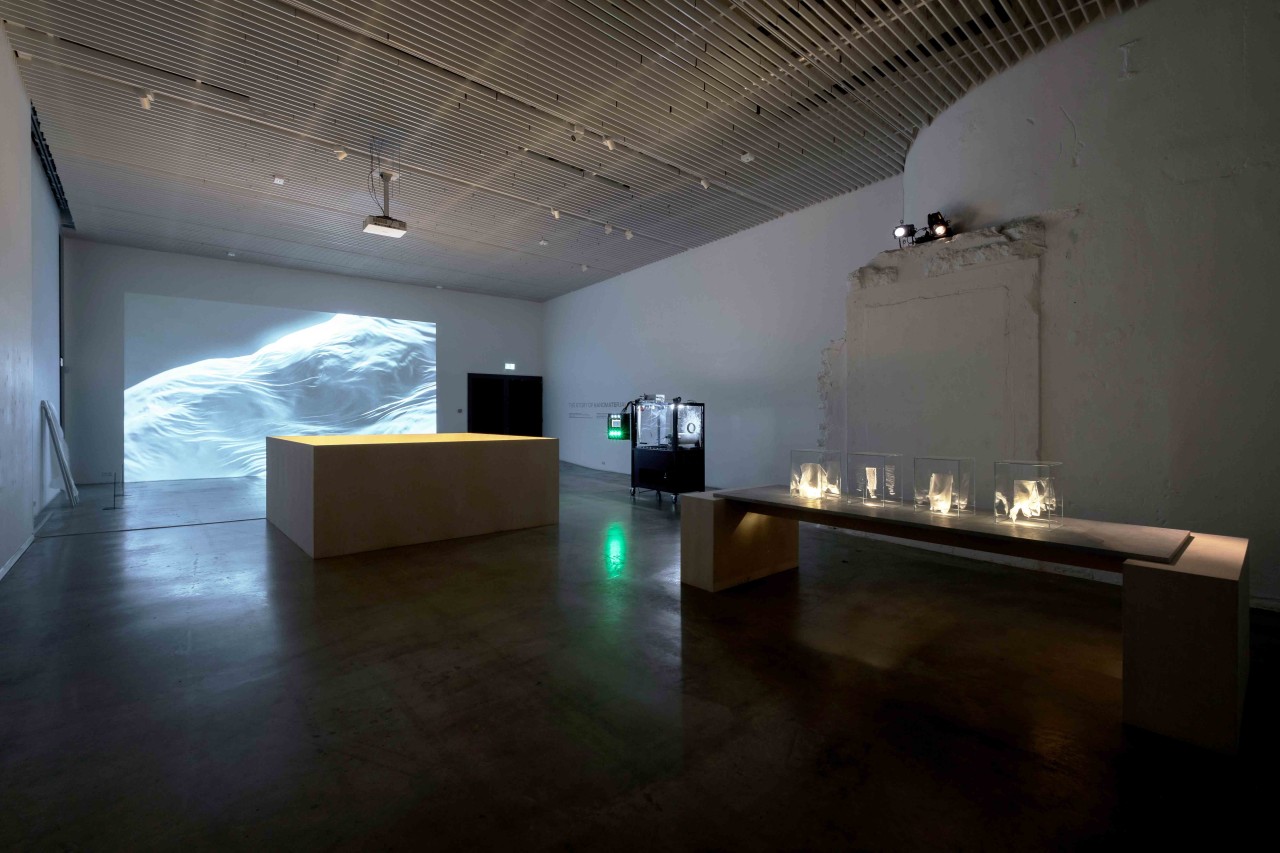
“What then is weight in such a world? To us, they might seem weightless, almost as if floating in the vast expanse of nothingness. But to them, every minuscule force matters, every interaction counts.”
15.09.23
The thickness of our everyday office paper is 100,000 nanometres.3 How many nanometres would be the size of legible text or the thickness of printed ink on paper? The scientist Tom Newman already transferred the famous opening paragraph of Charles Dickens’s A Tale of Two Cities onto the head of a pin using an electron beam in 1985.4 In 1959, the theoretical physicist Richard Feynman, who is known as the inventor of nanotechnology, laid down the challenge to print a text on the scale of 1/25000. The prize was 1000 dollars. He proposed this challenge during his lecture There’s Plenty of Room at the Bottom: An Invitation to Enter a New Field of Physics.5 Using contemporary technologies, texts that are smaller than an atom can be used today6 and Feynman had already predicted this 64 years ago.
When Pierre Satoshi Benoit was preparing the graphic design of the exhibition, he made attempts to print the smallest legible text on paper and ended up using the font size of 4.5 point. The text was only readable with a magnifying glass. The letters were then enlarged and used in those parts of the sentences in the exhibition text which had been generated by ChatGPT. This distorted text was distinguished in its irregularity from the precise text written by Haeun Kim.
Pierre also experimented with minimising the amount of ink, using only 15% of it. The enlargement of the printed text was, in turn, hand transferred on the gallery wall using 16400 dots and forming the title of the exhibition: The Story of Nanomaterial No. 399 in red ink and in Estonian above it Nanomaterjal nr. 399 in black ink. The title itself was partially generated by ChatGPT and is an excerpt from one of the iterations of a dialogue with artificial intelligence. AI has been present throughout the material development process and has assisted in documenting and analysing the recipes.
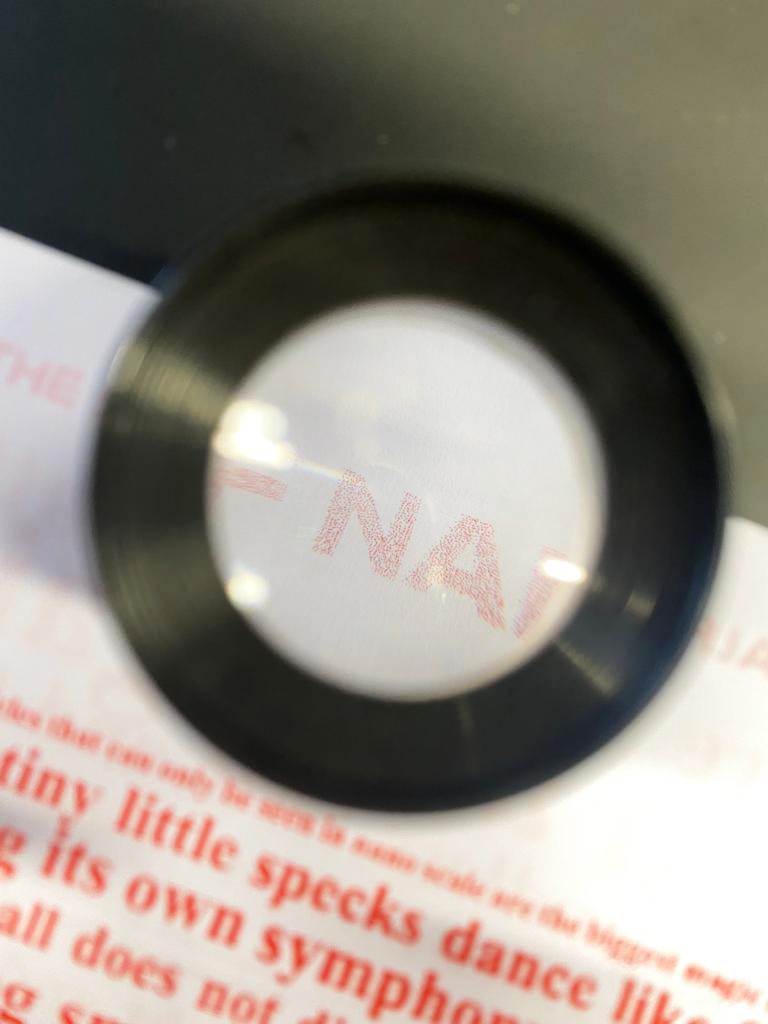
When it came to illumination, we decided to keep the windows of the gallery covered and the space dark. Lights were used only in places which needed emphasising, and instead of ceiling lights, lamps were brought near the exhibited objects. A soft cold general light was cast only by the video projection and the electrospinner. To illuminate the text by Haeun Kim on the wall and the limestone details, a couple of spotlights with a narrow beam were used. The illumination of the exhibition surfaces was carried out using furniture spotlights which were supported on the process table by wire stands and their light was directed using shades made out of insulating tape. On the table with the display cases, the lights were hidden under slits which had been cut into the limestone. In this way, only the white nanomaterials floating above the table were illuminated.

Photo: Annika Kaldoja
“The biggest magic in the unseen.”
30.11.23
The materials inside the display cases still quiver in the soft glow of the lights. We remove the cases and the fabrics rise weightless into the air, moving in slow motion like aquatic plants in the ocean. The first experience of seeing electrospun fabric ten years ago was mesmerising. The way the material floated in the air was very compelling. It didn’t even need to have an application or a use.
The relationship between the nanomaterial and the person has been at the same time intimate and distant throughout the process. Paradoxically, it melts away the moment it touches human skin. This means that the author’s relationship with the material is complex: although it is based on the characteristics of the base materials, the substance is still forced into a context which it lacks in its initial state. All natural primary materials in their powdered form are seemingly anonymous, but the researchers still have theoretical knowledge about their origin and composition. Everything that follows is merely formulas, experiments and working with machines. The result is an ephemeral material which the author has never touched in any of the stages of its creation. The decisions of the author are, however, visible and recognisable in the way the material behaves.
“They can slip through cracks, join each other, and make universes. The universe humans can’t even fathom. For what though? To whisper secrets.”
01.12.23
We push the electrospinning machine back into the lab with Madis so that the experiments can continue the next week.
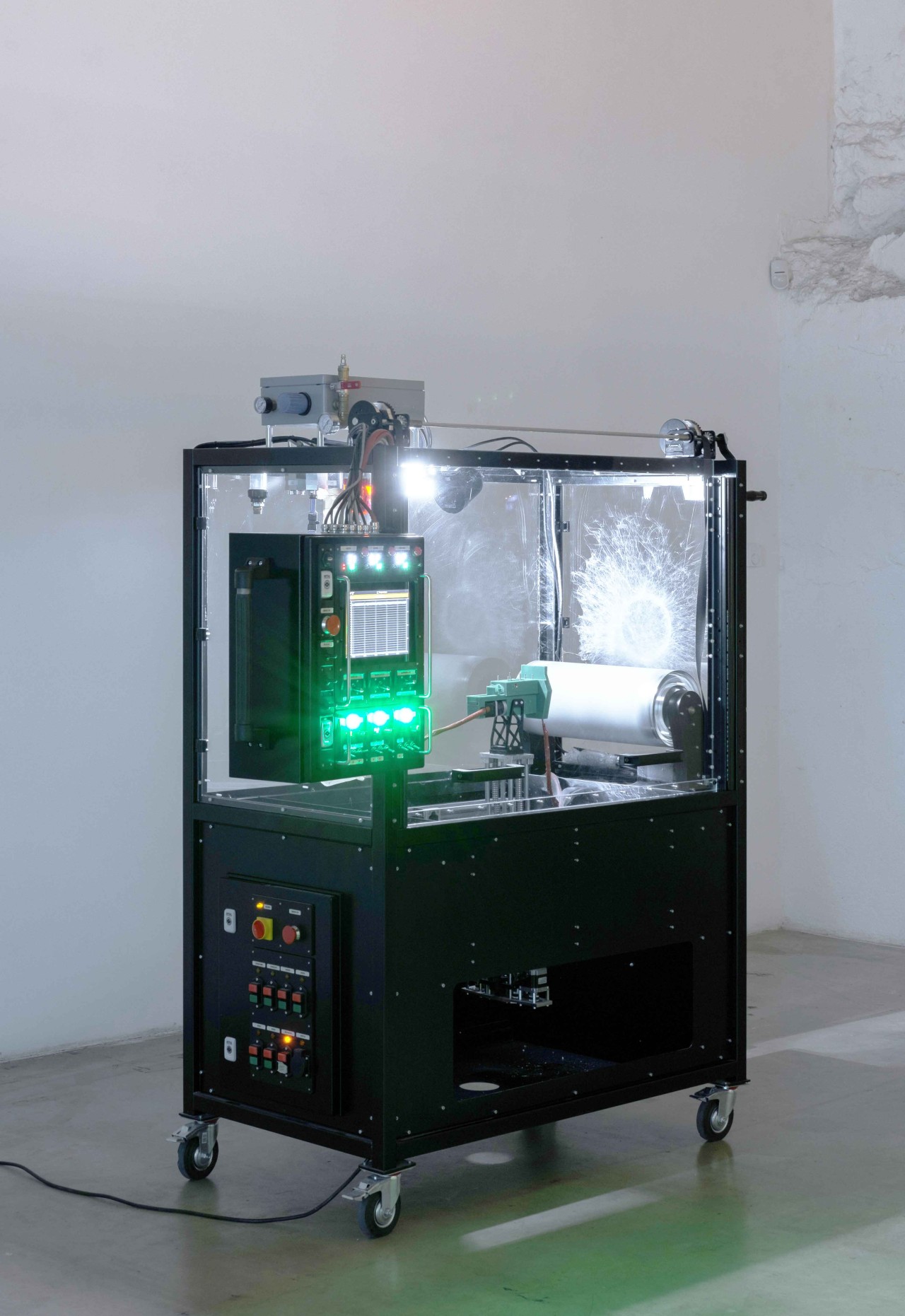
The author of the texts accompanying the exhibition made dozens of iterations of conversing about nanomaterials with various versions of ChatGPT. Artificial intelligence sifted through complex scientific articles about materials and philosophy. In the end, the exhibition was accompanied by the very first attempt at conversing about this topic. At that moment, neither Haeun nor ChatGPT knew anything about the technical parameters or other characteristics of the nanomaterial. The sentences were begun by the person and finished by AI.
“Small particles that can only be seen in nano scale are the biggest magic in the unseen. Those tiny little specks dance like fireflies, creating its own symphony in darkness. Being small does not diminish their grandeur. But being small offers them freedom. They can slip through cracks, join each other, and make universes. The universe humans can’t even fathom. For what though? To whisper secrets. The secrets of life’s intricate tapestry. The tiny things are hidden under veils of everyday sight. Though it is not visible, they work in harmony, shaping destiny.” (Haeun Kim / ChatGPT)
The exhibition took place in the gallery of the Estonian Academy of Arts 7–30 November 2023
Author: Kärt Ojavee
Material development team: Anna Jõgi, Katarina Kruus, Kärt Ojavee, Madis Kaasik in collaboration with Exponential Technologies Ltd. and Gelatex Technologies OÜ
Marie Vihmar (University of Tartu) participated as a guest at the exhibition
Exhibition design: Annika Kaldoja
Graphic design: Pierre Satoshi Benoit
Exhibition text: Haeun Kim in collaboration with ChatGPT
Sound design: Artjom Astrov
References
- Kröger, B., A. Penny, Y. Shen, A. Munnecke, Algae, calcitarchs and the Late Ordovician Baltic limestone facies of the Baltic Basin, Facies, 66 (2020), p. 2.
- Boholm, M., R. Arvidsson, A Definition Framework for the Terms Nanomaterial and Nanoparticle, NanoEthics, 10 (2016), pp. 25–40 (lk 36).
- Muhammad Sajeer P, Unveiling Philosophy and Social Aspects of Nanotechnology: A Short Review, (2022) <https://doi.org/10.48550/arXiv.2201.07183>
- Jane S. Dietrich, Tiny Tale Gets Grand, Engineering and Science, 49 (3) (1986), pp. 24–26.
- Richard P. Feynman, There’s Plenty of Room at the Bottom, Engineering and Science, 23 (5) (1960), pp. 22–36.
- <https://www.newscientist.com/gallery/dn16474-tiny-letters> [accessed 27 November 2023]